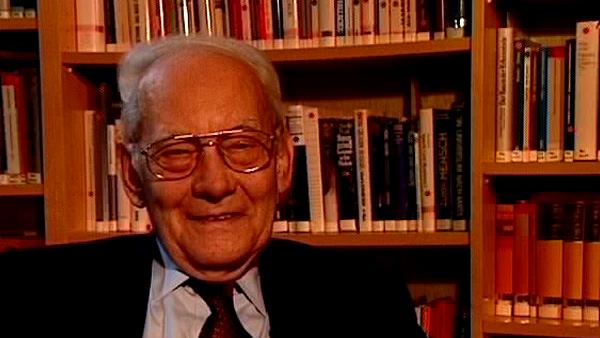NEXT STORY

Proving the hypercycle system
RELATED STORIES

NEXT STORY

Proving the hypercycle system
RELATED STORIES


|
Views | Duration | |
|---|---|---|---|
| 51. A nice story about quasispecies | 223 | 01:06 | |
| 52. Günther Strunk's true evolution experiment | 186 | 03:08 | |
| 53. Nature finds a way not to calculate everything in detail | 151 | 05:53 | |
| 54. A chance meeting with Francis Crick in Mainz | 233 | 01:02 | |
| 55. What does a hypercycle do? | 355 | 03:42 | |
| 56. Proving the hypercycle system | 181 | 03:49 | |
| 57. The Hypercycle - A Principle of Natural... | 1 | 265 | 01:12 |
| 58. No theory without experiments, no experiments without theory | 389 | 04:40 | |
| 59. The necessity for the theory for hypercycles | 161 | 01:46 | |
| 60. Einstein and the theory of quantum mechanics | 334 | 01:45 |


What does a hypercycle do? We said hypercycle links certain control units together to overcome error threshold, and secondly it solves the genotype/phenotype dichotomy. In other words you test your system at the phenotype and you must make sure that the phenotype tells the genotype, 'reproduce me'. And so, where could we find possibly a hypercycle? Well the best system again is a virus. In a virus, now... not a virus like Spiegelman did in vitro, that means in a test-tube, but the virus in vivo, in other words a virus infecting a host cell. And we took again our pet Q-beta, and Michael Gebinoga did this as a thesis.
What did he do? He took a coli culture and infected the coli culture with the phage, Q-beta, for certain amounts. This sample for one minute, the next sample for two minutes, up to forty minutes. After forty minutes the cells burst and about ten thousand viruses are sent out into the solution. So he did it... now he stopped the reaction when I said infected for one minute, it means he stops the reaction after a minute. Then he took these infected cells and he solved very carefully with phenol the outer membrane, the lipid membrane, and what is left is a ghost frame which can be penetrated by enzymes. And now he used these ghost cells and measured the kinetics using radioactive amino acids and radioactive building blocks for nucleic acids. He measured the protein synthesis and the nucleic acid synthesis. And then got the mechanism of it. And what came out are hypercyclic mechanism.
What does it mean? Well, I describe perhaps the mechanism of infection. Infection means one single nucleic acid molecule gets into the cell, through a pilus... the virus docks at such a pilus and injects its nucleic acid. Now you have one little nucleic acid molecule that is the virus genome in the host cell. The host cell has about ten to twenty thousand ribosomes, these are the machines which make protein synthesis. This little nucleic acid cannot reproduce, at least there are so many messenger molecules in the cells that it had no chance to reproduce. This virus has in its information the information for an enzyme which only replicates a virus, but for that you must translate, you must produce a phenotype of the enzyme. So what we found with our measurement, during the first ten minutes, only translation takes place. All these ribosomes in the cells, these protein factories, translate this one single molecule, one single RNA molecule.
Nobel Prize winning German biophysical chemist, Manfred Eigen (1927-2019), was best known for his work on fast chemical reactions and his development of ways to accurately measure these reactions down to the nearest billionth of a second. He published over 100 papers with topics ranging from hydrogen bridges of nucleic acids to the storage of information in the central nervous system.
Title: What does a hypercycle do?
Listeners: Ruthild Winkler-Oswatitch
Ruthild Winkler-Oswatitsch is the eldest daughter of the Austrian physicist Klaus Osatitsch, an internationally renowned expert in gas dynamics, and his wife Hedwig Oswatitsch-Klabinus. She was born in the German university town of Göttingen where her father worked at the Kaiser Wilhelm Institute of Aerodynamics under Ludwig Prandtl. After World War II she was educated in Stockholm, Sweden, where her father was then a research scientist and lecturer at the Royal Institute of Technology.
In 1961 Ruthild Winkler-Oswatitsch enrolled in Chemistry at the Technical University of Vienna where she received her PhD in 1969 with a dissertation on "Fast complex reactions of alkali ions with biological membrane carriers". The experimental work for her thesis was carried out at the Max Planck Institute for Physical Chemistry in Göttingen under Manfred Eigen.
From 1971 to the present Ruthild Winkler-Oswatitsch has been working as a research scientist at the Max Planck Institute in Göttingen in the Department of Chemical Kinetics which is headed by Manfred Eigen. Her interest was first focused on an application of relaxation techniques to the study of fast biological reactions. Thereafter, she engaged in theoretical studies on molecular evolution and developed game models for representing the underlying chemical proceses. Together with Manfred Eigen she wrote the widely noted book, "Laws of the Game" (Alfred A. Knopf Inc. 1981 and Princeton University Press, 1993). Her more recent studies were concerned with comparative sequence analysis of nucleic acids in order to find out the age of the genetic code and the time course of the early evolution of life. For the last decade she has been successfully establishing industrial applications in the field of evolutionary biotechnology.
Tags: Virus, error threshold, genotype/phenotype dichotomy, hypercycle, Q-beta virus, Michael Gebinoga, Sol Spiegelman
Duration: 3 minutes, 43 seconds
Date story recorded: July 1997
Date story went live: 24 January 2008